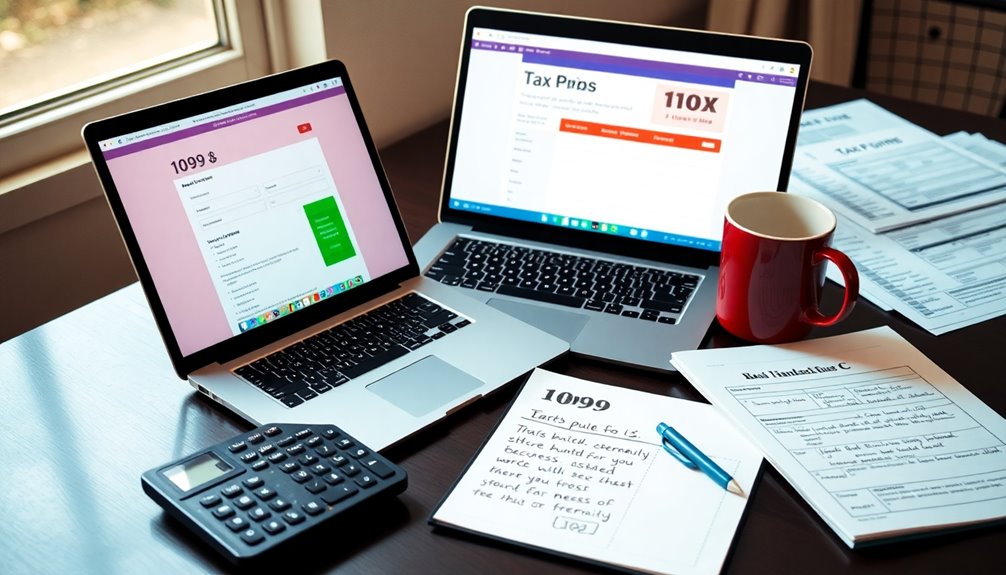Yes, you need a W-2 to file your taxes if you're an employee. This form details your annual wages and how much tax was withheld throughout the year. Without it, you might struggle to report your income accurately, which is crucial for compliance and avoiding penalties. If you haven't received your W-2 by January 31, reach out to your employer or the IRS for assistance. For independent contractors or self-employed individuals, you'll use a 1099 form instead. Knowing your options and requirements can help you navigate the tax process smoothly. There's more to explore on this topic ahead!
Key Takeaways
- A W-2 form is essential for accurately reporting annual wages and taxes withheld when filing federal and state income tax returns.
- Employees must receive a W-2 if they earned $600 or more from an employer during the tax year.
- Filing taxes without a W-2 is possible by using Form 4852, but it requires estimated wages and may trigger IRS scrutiny.
- Missing a W-2 can lead to penalties; it's crucial to contact your employer or the IRS if not received by January 31.
- Independent contractors do not receive W-2s; instead, they need to file using 1099 forms if they earned income as self-employed individuals.
Purpose of a W-2

The purpose of a W-2 is crucial for understanding your tax obligations and ensuring accurate reporting. This form reports your annual wages and the taxes withheld from your paychecks, including federal, state, Social Security, and Medicare taxes. It's essential for you to file both federal and state income tax returns accurately, as the W-2 reflects your earnings and deductions for the previous year.
The W-2 details the FICA taxes withheld, which include your contributions to Social Security and Medicare. It breaks down the amounts withheld for federal income tax, Social Security tax, and Medicare tax, ensuring you have a clear understanding of your contributions. Additionally, it lists various employee benefits, showing income from wages, tips, and bonuses, some of which might be taxable. Employers must send W-2 forms to you by January 31 each year and file them with the Social Security Administration (SSA). This compliance ensures that your income is reported correctly, which is vital for calculating your future Social Security benefits. Correct classification of workers is essential for employers to avoid penalties and ensure accurate tax reporting.
Who Receives a W-2

If you're employed by a U.S. company or organization, you'll likely receive a W-2 form each year. This form is essential for employees who've a formal employment relationship, including both full-time and part-time workers. If you've been hired under a contract or agreement, your employer is required to provide you with a W-2 as long as you earned at least $600 during the year. Keep in mind that independent contractors and self-employed individuals don't receive a W-2; they typically get a 1099 instead. Your employer must issue a W-2 for any compensation paid, regardless of the total amount you earned. Even if your earnings fall below the tax filing threshold, you'll still receive a W-2. Additionally, W-2 employees are entitled to benefits and protections under US law, which independent contractors do not receive.
Information Included on a W-2

A W-2 form contains crucial information that helps you accurately report your income and taxes when filing. First, it includes your name, address, and Social Security number in Box A, ensuring your identity is verified. The employer's information, like their name, address, and Employer Identification Number (EIN), is also provided, which establishes the source of your income.
The form details your total taxable income in Box 1, encompassing wages, tips, bonuses, and commissions. Additionally, Box 2 shows how much federal income tax has been withheld throughout the year. Furthermore, the W-2 form is an essential document for income tax reporting in the U.S.
Boxes 3 and 4 report your earnings subject to Social Security tax and the withheld amounts, while Boxes 5 and 6 cover Medicare taxes.
You'll also find state and local tax information in Boxes 15-20, which is crucial for your overall tax calculations. Box 13 indicates your statutory employee status or participation in retirement plans, while Box 14 can include details like union dues or uniform payments.
Deadlines for W-2 Submission

When it comes to filing your taxes, knowing the deadlines for W-2 submission is essential. Employers must send W-2 Forms to you by January 31 each year, whether by mail or electronically, as long as you've consented to the electronic distribution.
If you haven't received your W-2 by this date, it's crucial to contact your employer immediately, or reach out to the IRS by the end of February.
For employers, submitting Copy A of the W-2 to the Social Security Administration (SSA) also has a January 31 deadline. If they're filing 250 or more forms, they're required to e-file, which is recommended for faster processing. It's important to note that W-2 forms must be furnished to recipients by January 31.
Along with the W-2 submissions, employers must include Form W-3.
Keep in mind that state deadlines may differ, although many align with the January 31 federal deadline. So, it's wise to check your state's requirements to ensure compliance.
Late filing can incur penalties, so both you and your employer should prioritize timely submission to prevent any issues when it's time to file your taxes.
Using Your W-2 for Taxes

Using your W-2 for taxes is crucial for ensuring an accurate and efficient filing process. First, gather all your W-2 forms from your employers. Make sure the names and Social Security numbers on the W-2 match your Social Security card. Verify the accuracy of the wages, tips, and tax withholding information listed on each form. It's best to keep all your W-2s organized along with other tax documents for easy access.
Understanding the components of your W-2 is equally important. Box 1 shows your taxable income, which includes wages, salary, tips, and bonuses. Box 2 indicates the federal income tax withheld, while Boxes 3-4 detail your earnings and Social Security tax withholding. Boxes 5-6 outline your Medicare pay and taxes withheld.
When reporting your income and taxes, remember that W-2 forms also capture Federal Insurance Contributions Act (FICA) taxes. This data is vital for the IRS, as it uses your Social Security number to verify your information. Additionally, military-specific tax benefits can further impact how you utilize your W-2 during tax filing.
Accurate W-2 data not only ensures proper tax filing but also records your lifetime earnings for future Social Security and Medicare benefits.
Consequences of Missing a W-2

Missing a W-2 can lead to significant consequences, both financially and administratively. If you fail to file your W-2 on time, you might face penalties ranging from $60 to $630, depending on how late the form is submitted.
For instance, if you file within 30 days of the January 31 deadline, you'll incur a minimum penalty of $60 per form. If it's filed between 31 days after the deadline and August 1, that penalty jumps to $120. Filing after August 1 can cost you $310 per W-2. If you intentionally disregard filing requirements, the penalty could soar to $630 with no cap. Moreover, compliance with federal law is required regardless of employee earnings, which highlights the importance of timely and accurate W-2 submissions.
Additionally, if you're running a small business with gross receipts of $5 million or less, penalties can be even steeper, starting at $50 per form. Errors on your W-2, like incorrect tax identification numbers or misclassified employees, also result in additional penalties.
To mitigate these consequences, you can apply for an extension or demonstrate reasonable cause for late filing. However, it's crucial to take action promptly to correct any mistakes and minimize your financial exposure.
Alternatives to W-2 for Filing

If you've lost your W-2 or haven't received it from your employer by the tax filing deadline, you still have options for filing your taxes. One effective alternative is to use Form 4852, which serves as a substitute for missing W-2s or 1099-Rs.
You can file this form if you've been unable to obtain the original or corrected documents by the end of February, and you've sought IRS assistance without success. To complete Form 4852, enter your name, Social Security number, and address. Specify the tax year and indicate if it's a substitute for a W-2 or 1099-R.
You'll need to provide your employer's details and report your estimated wages, tips, and taxes withheld based on your paystubs or distribution statements. Additionally, it's important to note that you should always attempt to retrieve missing forms from your employer before resorting to Form 4852.
Frequently Asked Questions
Can I File Taxes Without a W-2 if I Have Other Income?
Yes, you can file taxes without a W-2 if you have other income.
You'll need to report that income accurately on your tax return. If you don't have your W-2, you can use Form 4852 as a substitute, estimating your wages and withholding from your last pay stub.
Just remember to file by mail and be prepared to amend your return if the official W-2 arrives later with different figures.
What if My W-2 Contains Incorrect Information?
If your W-2 contains incorrect information, start by contacting your employer or HR department to report the error.
Compare your W-2 with your final pay stub to verify discrepancies. Request a corrected W-2, known as W-2c, before the end of February.
Make sure to check its accuracy once you receive it. If your employer doesn't correct it, you may need to involve the IRS for further assistance.
How Can I Obtain a Lost W-2 From My Employer?
If you've lost your W-2, start by checking with your employer's HR or payroll department.
They can help you track down the original or reissue a copy. Make sure they've your correct mailing address.
If that doesn't work, consider contacting a third-party payroll provider if applicable.
You can also ask for a duplicate from the IRS or use your last pay stub to estimate your earnings for filing.
Are W-2s Required for Part-Time or Temporary Jobs?
Yes, W-2s are required for part-time and temporary jobs if you're classified as a W-2 employee.
If your employer controls your work, pays you regular wages, and considers you essential to their business, you'll receive a W-2 at year's end. This form shows your earnings and taxes withheld.
Do Independent Contractors Receive W-2 Forms?
Independent contractors don't receive W-2 forms. Instead, they get 1099 forms that report their nonemployee compensation.
W-2s are specifically for employees, where employers withhold taxes on wages. As an independent contractor, you're responsible for your own tax withholding and must pay estimated taxes quarterly.
Conclusion
In summary, you do need a W-2 to file your taxes if you've had a job where your employer withheld taxes. It provides essential information about your earnings and tax withholdings. If you don't receive one, it's crucial to follow up with your employer or use alternatives like a 1099 form, if applicable. Filing without a W-2 can lead to complications, so make sure you've got all the necessary documents before you start your tax return.









